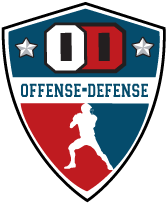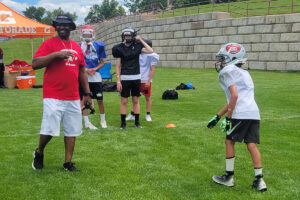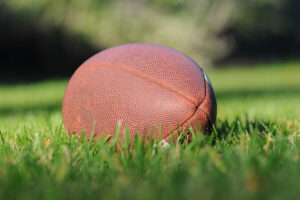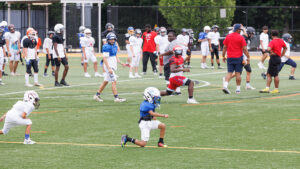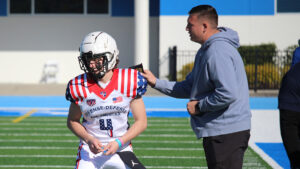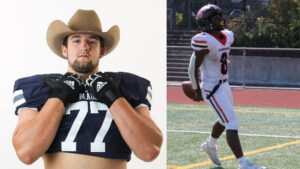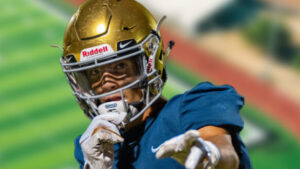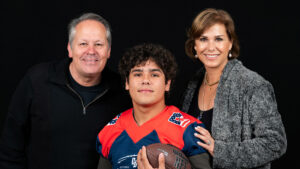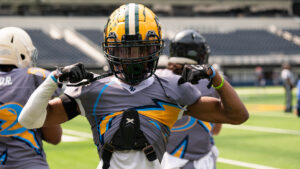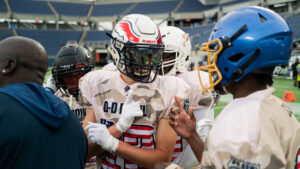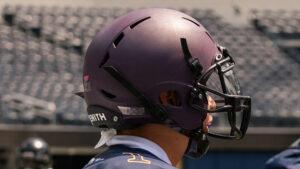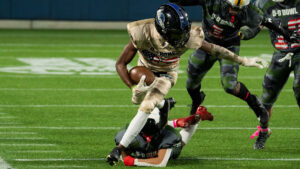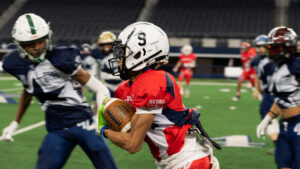The Line of Scrimmage Podcast is all about football! Tune in weekly to your host Coach Greg Quick to learn everything there is about the current state of football, history, top athletes, special guests and more on the all new podcast brought to by Offense-Defense Football.
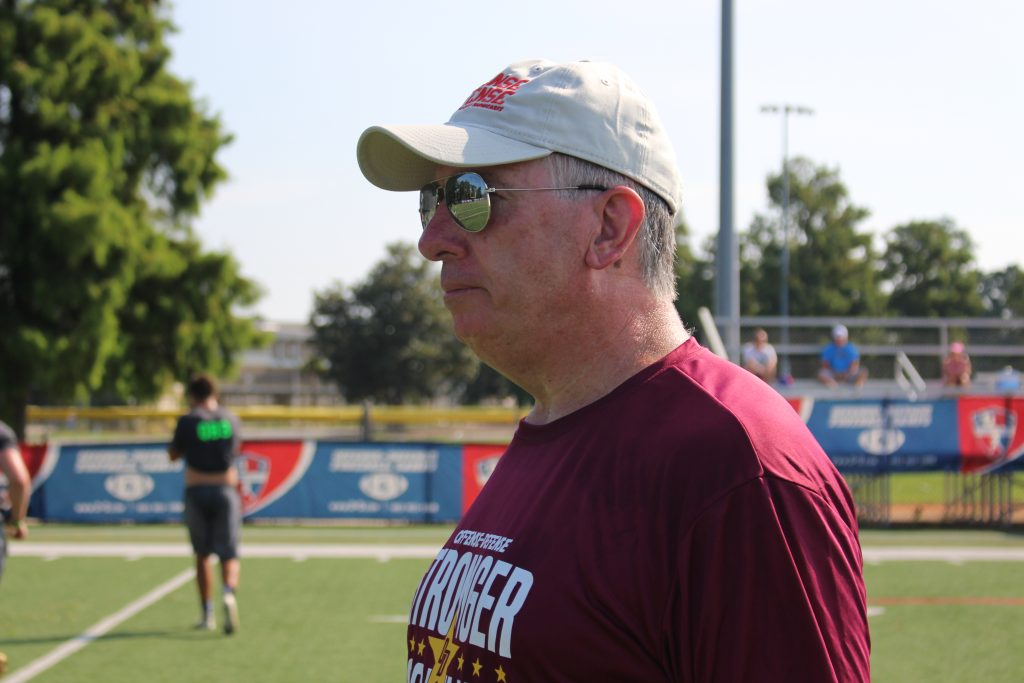
ABOUT COACH QUICK
Greg Quick is currently the Canadian Football League Director, Global Scouting. GQ has nearly four decades on the sidelines including high school, university and professional football. He has sixteen years as a university head coach in addition to coordinating both sides of the ball and tutoring linebackers to quarterbacks and everything in between. Coach Quick began his relationship with O-D in 1986. Greg and his wife, Jeannie, have six children and two grandchildren.
ABOUT THIS EPISODE
The Line of Scrimmage, Episode 7 – Talking Ball “Tackling Concepts”
This week on The Line of Scrimmage powered by Offense-Defense Football Camps Coach Quick goes over the fundamentals of becoming a great tackler. So tune in to give it a listen!
This is episode seven of our podcast. Today. We’re talking ball a new rotating feature where we’re going to discuss tactical aspects of the game of football. This week. We’re going to explore the four fundamentals of tackling, but first quick news, that’s right. Quick news. Coach prime takes over at Jackson state. Deion Sanders was announced as the head football coach at FCS Jackson state university. Last week, it’s claimed that the staff has 84 combined years in the NFL, his coaches and or players, coach Prime’s vision for changing the culture involves establishing JSU as a pathway to the league. That’s right to the NFL. Deon knows that football can be the portal for fulfilling futures for many young men on and off the field. Good luck Dion from week two of the NFL, no mask fines was this good or bad. 1.75 million in fines, levied against five NFL head coaches and their teams for not wearing masks on the sidelines.
Speaker 4 (01:42):
During week two of the NFL season, a hundred thousand each coach, and 250,000 each team was this good or bad, not good if it went to the Roger Goodell golf fund, right? But the monies are donated through the NFL foundation to the legends of need fund. Since 2009, an average 4 million each year goes to assist former players in need. Thus, this has a good ending increasing available funds by 50%. During these challenging times now tackling what’s tackling tackle means to deal with, to try to deal with something or someone making a determined effort to deal with a problem or a difficult task in football that difficult task is bringing down the ball carrier, tackling the ball here, dealing with the ball carrier. So we’re dealing with something and someone, this is a problem in a difficult task for defenses. So let’s talk about the four components of tackling leverage launch lock in land.
Speaker 4 (02:45):
First, leverage location, location, location in football, and in real estate, it matters location, location, position yourself for success. There’s two components to leverage in tackling, leverage your location relative to the ball. Carrier low lies near him. I believe the eyes are so important in every skill in football. We talk about eyes, hands and feet in every tactical component that we’ll talk about in the coming weeks in talking ball, but you need to have low eyes on the near hip to tackle. And this is consistent with everything. I teach all the tactical components of playing linebacker. Start with the eyes and low wise. So we use low lies on the near hip. When we’re tackling, we use low eyes on the near hip. We’re playing man coverage, and we use low eyes to the near hip when we’re blitzing. And we’re trying to get the best get off.
Speaker 4 (03:42):
Our eyes are on the near hip of that offensive tackle, where that in man in the line of scrimmage. So as soon as that hip moves, we’re shot out of a cannon. So the first is that leverage position where our eyes, where are we located to the ball carrier? So we use our eyes on the near hip. The other is we’ve got to get close. We don’t want to react to the situation too early. So we talk about the person tackling, stepping on the ball, carrier shadow, step on a ball carrier shadow. If you get close enough to step on your shadow, you’re ready to execute a tackle. Don’t react to the situation to her. You know, there’s an old saying don’t fire until you see the whites of their eyes. This saying comes from an order legitly given by an American officer, William Prescott at the battle of bunker Hill in the American revolutionary war.
Speaker 4 (04:33):
The firearms at this time are one shot muskets. There are more ms. Tackles caused by firing to suit. One must be properly positioned. You only get one shot, just like the men on bunker Hill. Don’t fire too. You see the whites of their eyes step on her shadow. The other component of leverage, the first of our tackling fundamentals is leverage or positioning of the tacklers body. So our location relative to the ball carriers we discussed is really important. Low highs, near hip step on the shadow. Now we’re going to look at the leverage or the positioning of the tacklers bodies. We want a low center of gravity. We want to consolidate and synchronize all of our resources, no different than they do in business, right? You want to consolidate and synchronize your resources. So you’re using all your areas of strength. You want to consolidate and synchronize your resources.
Speaker 4 (05:28):
You want to bring all your strengths to bear on that situation so you can maximize all those resources moving forward. So we want to add cackling. We need to lower our surge gravity as part of the leveraging. So we want a low center of gravity, but as we lower our center of gravity, it’s important that we maintain momentum through the ensuing, the launch. We don’t want to stop lower center of gravity and then attempt to make a tackle. We want to maintain momentum and lower our center of gravity, triple bed, ankles, knees, and hips. If we’re able to get a triple bend, this allows us to have triple extension. When we launch, we can use the long jump as a great example of how we should tackle, just like the long jump. The last three tackles before we launched many times are going to affect our ability to make a successful tackle.
Speaker 4 (06:19):
As in the long jump, we want to drop our center of gravity, but we don’t want to lose momentum on the run-up. The same is true in this open field tackle. The last three steps are so important. First step. We want a full foot strike, not on the balls of our foot, but want to use our full foot strike by hitting a full foot strike or on a flat foot. It lowers our center of gravity. Now, when we lower our center of gravity with that flat foot or that full foot strike, it forces a longer second step. And the reason that longer second step is so important is that it maintains the momentum into the tackle. If you shorten that second step, if you don’t lengthen that second step, you’re going to start to minimize the momentum you have to take into the tackle. So let me review first step flatfoot full strike, lower the center of gravity.
Speaker 4 (07:11):
And then on the second step, we want a long step that maintains momentum. Then on the final and third step, this is a shorter step. And this leads into the launch. And that shorter step allows us to have greater agility that have the ability to adapt to the changing location, to the bulkier. Without that last, that third step being shorter will not be able to adjust to the changing location and the ball cured. The second component of tackling, the second fundamental I teach is the launch. The launch is when you Genesin through contact, just like launching a rocket. You want to Jennison through the contact. You want triple extension, you want a hundred percent commitment. Let me give you an analogy of what triple extension is. We all test the triple jump at all. Often we ask, well, how high they jump? Was it 30, 35, 40, 23?
Speaker 4 (08:08):
What was their vertical job? And that measure is very meaningful. As we assess talent football. What I like to do though, is I want a video of that vertical jump. Sure. The inches are really important, able to draw an analogy you between the higher the jump and then her abilities as a football player, their power, their ability to force against the ground and elevate. But for me, I want to see the triple extension. I want to see extension at the ankle, knee and hip. If they’re able to get that triple extension, if I’m watching a linebacker, that’s do it a vertical jump or a defensive back. That’s going to vertical jump. But I see that triple extension. I often know that they’re going to be able to, to jettison theirselves through. It’d be a good tackler. I need that hundred percent commitment of a great extension in the ankles, knees and hips.
Speaker 4 (09:03):
Also on the launch, as we talked about that last step in leverage, as we come in that last step, that third step is a shorter step that allows us to adapt to change. So we have to be prepared in the launch. As we go to jettison ourselves through contact, to be able to adapt, to change. We’re not tackling a stationary dummy we’re tackling and a dynamic elite player. We’ve got to use agility and intuition. We’re going to hit the strike zone or the thighs or the lower leg. We know the safety and tackling comes from the shoulder down. And I believe there’s three areas that we’re going to end up tackling either in the strike zone, the top of the numbers to the navel or the thighs or the lower leg. We’re going to end up in one of those three areas, but we’re going to have to be able to adapt to the dynamic change to that elite player.
Speaker 4 (09:56):
That’s carrying the ball so that within our launch, we’re able to adapt to the location, whether it’s a strike zone, the thighs of the lower leg. And we’ll talk more about this. When we get into the land 10,000 reps to gain an intuitive reaction, we got to maximize the repetitions through using similar motion patterns in a diverse array of activity, whether it be drills and tackling servants circuits in practice. We also have to look at what we do in our training. We can do dumbbell or weighted vests, lunges, and leaps and bounded, whether with a sled or again, with a weighted vest or a dumbbell, we can get applications that, that utilize the fundamentals of tackling. We can use the tackling donut that requires visual tracking. There are robots today, the require visual tracking because it’s ability to track visually as we launch, it’s going to allow us to adapt or change, but we can utilize the weight room, our training, our warmup, our drills, our circuits to gain those 10,000 reps there allow us to gain that intuitive reaction that allows us to adapt and change readily within our launch ODI football camps at power, the line of scrimmage podcast, the ODI football camps know about leverage and launch 15 years ago, Odie leverage their reputation as the number one contact football camp in the USA into the launch of the All-American bowl series of regional and invitational games that culminate in a national championship bowl.
Speaker 4 (11:38):
The regional games for this year have been announced. Players may still be nominated. These are once in a lifetime experiences. The first on the East coast is December 27th through the 30th in Myrtle beach, South Carolina at Pelican stadium and in the West, January 26th to the 29th at eight T and T stadium in Arlington texts to nominate a player on the web, go to o-d.com. You can find the nomination if you would type in o-d.com backslash player, hyphen nomination backslash. So go to odie.com and nominate a player today. This is a once in a lifetime experience. It can be shared by player and family alike. Now the next component of tackling the lock, the lock is how we’re going to restrain. It’s a forearm vise it’s violence to the ball. The number one cause of fumbles is violence to the ball. In an off season study, I did a couple of years ago, I found the just sheer violence to the ball causes fumbles.
Speaker 4 (12:48):
We’re not violently attacking our opponent. We’re violently attacking the ball as we tackle. If we will violently attack the ball will cause takeaways. It’s the number one cause of fumbles. The second, our quarterbacks, and to strip of the quarterback, you have ripped pool and you have, I have a pound or a punch and raised tackles. Those are all the forms ways of causing a fumble, but it’s the violence you strike. As you bring the forearms into the core of the that’s important. And we need to vise those forearms to strain the ball carrier. So we’re going to get our hands inside. We don’t know where that clutch will be, but if we vice with their forearms, we’re going to get the restraint we need. And then we need to draw it in. We talked about drills. We can do seated in inclined rows, mimic the lock.
Speaker 4 (13:40):
As we strike with those forearms and vice the core of the body. We need to draw it in. We need to eliminate space and draw that player into the core of the tacklers body. So violence with those forearms as they come device restrained the ball carrier array space, eliminate the separation rope, pull that in. So as we trained, as we exercise incline rows, dumbbell rows, maybe you include a role as you’re doing lunges. Cause a lunge puts you into that same position that you’re going to be in. When you tackle where you got great bend in your, in your hips, in your knees, in your ankles. And now you’re going to draw your eliminate space. So as you draw, so you may do those lunges with dumbbells. And as you start to rise, you’re going to draw the row with the dumbbells and that’s going to sink her nice, similar to a tackle.
Speaker 4 (14:37):
So now you’re starting to establish the kinesiology necessary in those 10,000 reps to have the intuitive response in the tackle. So again, to review in the lock, it’s violence to the ball, the number one cause of fumbles. You come in violently with those forearms and you attack and you restrained and you erase space. You’re going to have an opportunity to move to the last component, which is the land, the land there’s, as we talked about, I think there’s three forms of land or bringing the bulk here to the ground. The first is the strike zone. Again, top of the numbers to the navel, the most advantageous spot to make the tackle. But we know that every tackle is a form tackle opportunity. So we’re going to strike through the strike. So we’re not going to slow down. What kind of competitor sees the finished slide and slows down, always finished strong.
Speaker 4 (15:32):
And it’s the land that often isn’t practiced enough to gain that repetitive, that 10,000 reps. Cause we don’t take people to the ground as often in practice anymore. So we have to establish and utilize drills, circuits, exercise, training methods that allow us to utilize those landing techniques. First, the strike zone, we’re going to strike from the top of the numbers to the navel. I want to equate it to Greco-Roman wrestling in Greco-Roman wrestling all the way back into Greek Olympics and now continues. But back into Greco-Roman wrestling of the Greek age, you have to wrap, you have to lock your opponent above the waist, just as we do in the strike zone. And then you have to throw, you have to land that opponent under the mat from that position. So you have to gain control in the strike zone and then you’ve got to complete or finish that take down or that land from that position, very similar also to Sumo wrestling, a Sumo wrestling.
Speaker 4 (16:42):
Often those matches last a minute or less. So I acquainted the tackling cause this is a fast, energetic dynamic activity. And similar, you may think a Sumo wrestling is slow, but it’s actually very fast and it takes quick moves. Again. The Sumo wrestlers are going to gain that lock and then they have to knock the opponent out of the ring or Greco-Roman wrestling like Sumo wrestling. When we hit that strike zone, we got a lock and then we have to land or opponent by running through. So strike zone. We run through again, strike zone run through don’t slow down. The second fundamental in landing is a roll tackle. This is what we’re trying to eliminate support. We’ve made contact in the thighs. We’ve come in, we’ve launched. We adapted to the moving, running back. We’re now jettisoning ourselves through the thighs. And now we’re same way.
Speaker 4 (17:41):
We’re going to lock with our forearms around the thighs. And we’re going to draw in the thighs drawed to our core. And then we’re going to rule. This is no different than steer wrestling. Go online, look up, steer wrestling, get a video and watch. And from the moment that’s a steer wrestler locks the horns, and you’re gonna see they’re going to lock the door orange the same way as I’m talking about how we lock in tackle, they’re going to lock those forearms around the horn and they’re gonna vice versa. And they’re going to try and draw that steer into their body. And they’re not going to roll to take the steer off its feet and they don’t win until all four feet are pointing the same direction straight up. And that’s the same thing we want to do when we roll, but we want to roll, continue to roll through till we haven’t on top position.
Speaker 4 (18:35):
And the reason we want to be positioned on top and finish just like I talked about the strike zone running through, don’t slow down until you have landed your opponent the same in a roll tackle. You’re going to lock. You’re going to roll and you want, continue to roll through to your on top. Why, why is that important? Because if the ball has been knocked loose, you can escape the position of the tackle. You can recover the takeaway, recover the fumble, or get up and block for your teammate. That’s recovered it. And now that takeaway becomes even greater. So it’s important that we finished the role so often I see young people, they go to a role, they eliminate the support. They get both the arms and legs facing up. They don’t roll through and now the ball’s on the ground. Everybody’s scampering for it.
Speaker 4 (19:24):
We’ve lost the opportunity for a takeaway and with the highest scoring offenses today, we’ve got to have takeaways. So to review roll tackle, we’re going to eliminate the support. We’re going to lock, roll and Le end up on top. And then the final type of tackle. The final way to land at running back is a slice. We’re going to chop wood. We’re going to fill the tree. So now we’re going to tack the lower leg. We’re going to jettison ourselves to the lower legs. So as we’ve approached in the law, the running back or the ball carrier has changed position to the point that when we judge that ourselves, we’re making contact with the lower leg, we’re going to chop wood. We’re going as we lock, we’re going to try and catch a heel or catch an ankle and draw it into the body. No different.
Speaker 4 (20:14):
Let me equate it to a lap pole. When you grab that bar and you draw it into you, you want to do the same thing. So as you strike and you go to a lock catching ankle, catchy heel, and draw it into you. As part of that slice tackle to me, the slice tackle is as dynamic and as similar to the slide tackle in soccer, it’s a dynamic move. It’s a dynamic way to take the ball away. That defender is able to slide in and take possession of the ball. They’re basically doing the same thing. We’re going to slice chop wood, grab a heel. So instead of grabbing the ball as a slide, tackler does with their feet, our objective is to catch a heel or ankle to fell that tree, to chop wood, the slice, to bring that running back down, to bring it, to land the running back.
Speaker 4 (21:05):
So if you have a chance, go watch some Greco-Roman wrestling online or Sumo wrestling, watch steer wrestling, pull up a video of a steer wrestler or pull up a video of a slide tackler in soccer. Cause if you do that, I think you’ll get the idea of the type of tackling and the athleticism and the violence that takes place in these techniques. So again, I hit the strike zone top of the numbers to the navel. I want to run through. Don’t slow down. Thanks for joining me to talk ball this week and talking ball will be a feature on a regular basis on the line of scrimmage podcast. I’ll look forward to talking again next week. God bless. Thanks for joining me to talk ball this week and talking ball will be a feature on a regular basis on the line of scrimmage podcast. I look forward to talking again next week. God bless.
